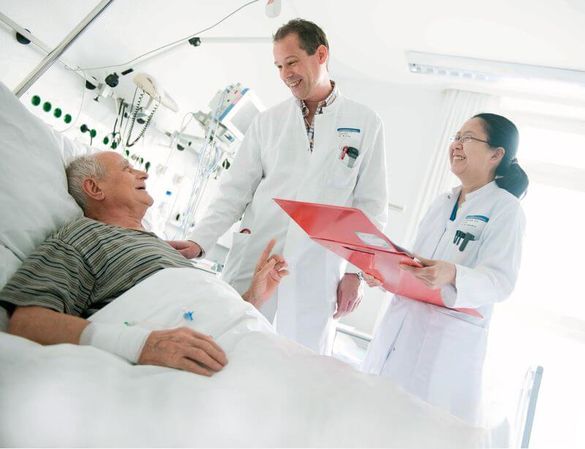Opening of the Heidelberg Center for Cardiac Arrhythmia (HCR)

June 2017
The Center for Cardiac Arrhythmia opened on July 1, 2017. Routine use of technical innovations facilitates treatment of complex diseases.
In the Department of Cardiology at Heidelberg University Hospital, approximately 800 cardiac arrhythmia patients are treated per year in the context of catheterization, and another 800 are supplied with pacemakers or implantable defibrillators - and this trend is increasing. In view of the increasingly complex treatment options also being developed over the past few years for various types of arrhythmias, the Department of Cardiology, Angiology and Pneumology, headed by Professor Dr. Hugo A. Katus, launched the Heidelberg Center for Cardiac Arrhythmia (HCR). Situated within the Heidelberg Heart Center, the goal of the HCR is to further develop interdisciplinary patient care and with it also expertise in the therapy of difficult-to-treat and rare clinical presentations.
"Over the past ten years, therapy for heart arrhythmias has become enormously important in our clinic. The number of patients has more than doubled over this time," explains Professor Dr. Hugo A. Katus, Head of HCR. "Thus, it seemed obvious that we should give the structures and collaboration that have developed a solid framework by establishing the Heidelberg Center for Cardiac Arrhythmia." Particularly outstanding features of the new center are the on-site availability of experts from various disciplines, the comprehensive diagnostic options of the University Hospital, the great expertise in complex catheterization interventions, and the close ties to research. The interdisciplinary network within the center is unique in the area. Depending on the arrhythmia, patients are treated by cardiologists, cardiac surgeons (medical director: Prof. Dr. Matthias Karck), and pediatric cardiologists (medical director: Prof. Dr. Matthias Gorenflo). This offers particular benefits for the treatment of children and adults with congenital heart defects. Such adults have usually undergone multiple heart surgeries, which complicates the obliteration of the areas of heart muscle triggering the arrhythmias.
With 3D mapping systems, the origin of the arrhythmia can be precisely identified and treated individually.
The other emphasis is on procedures which, due to their complexity, can only be offered at a few centers throughout Germany. One of these is the treatment of ventricular tachycardia (a fast rhythm originating in the large heart chambers) via an epicardial approach. "This relatively new procedure is a good treatment option for ventricular tachycardias, but requires a lot of experience," says Professor Dr. Eberhard Scholz, member of the HCR administrative board. The same is true for catheter ablation in the roots of the aorta or pulmonary artery. Hybrid interventions such as catheter insertion combined with surgery are often required with accompanying visualization of the coronary arteries. "The better the diagnostic capabilities, the more precisely the origins of the particular arrhythmia can be identified. This means that we perform ablations increasingly often on heart areas that are difficult to reach." Indispensable are the 3D mapping systems, which use the data from various imaging procedures as well as electrophysiological measurements to produce a three-dimensional map of the electrical conduction in the heart. It indicates which areas of the heart tissue are causing the arrhythmia and must be treated.
In addition to modern catheterization procedures, the Heidelberg Center offers technical innovations in the field of cardiac pacemaker and implantable defibrillator (ICD) therapy. With the S-ICD, the electrode is no longer attached within the heart, but can be placed outside of the ribcage, under the skin. "With this new type of ICD, fewer complications occur with the electrodes," says Privatdozent Dr. Edgar Zitron, the HCR board member responsible for ICD and pacemakers. Further innovations are wireless pacemaker systems to be anchored directly inside the right ventricle ("leadless pacing"). The experts assume that these techniques will be used more and more for suitable patients.
Further information:
Department of Cardiology, Angiology and Pneumology at Heidelberg University Hospital

